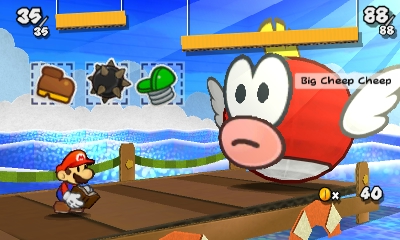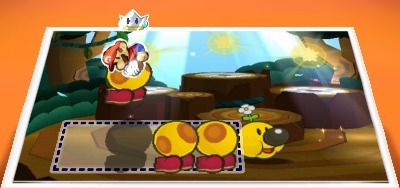There are few Nintendo titles I’ve seen more unanimously condemned than Paper Mario: Sticker Star, so, of course, I recently put almost 40 hours into it. As a fan of the Paper Mario titles that came before it, especially The Thousand Year Door, and someone who strives to look beyond the wider online opinion on games to discover them myself (I did review Other M a few months back, mind you), I had to find out for myself how I felt about the infamous 3DS title, and I did, after painfully thorough investigation. As it turns out, Sticker Star isn’t the horrible monstrosity everyone makes it out to be.
That doesn’t mean I enjoyed Sticker Star, though, just because I didn’t find it godawful. It’s the most bland, mediocre, and forgettable, yet playable, game I think I’ve ever encountered. It’s the saltine cracker of the video game world – it’s edible, it fills you up for a while, but you’ll become bored with it very fast, and you’d much rather go for something better. If I felt like playing something, but didn’t feel like taking Sticker Star out of my 3DS and swapping it out for something else, I could definitely play it. On the flip side, during the review process I set it down for a whole month, with no drive or interest in picking it back up, because, while it’s not terrible and it’s useful for killing time, I own plenty of more interesting games. In fact, I find the game’s saltine-esque nature and my lack of any solid feelings on it (other than annoyance that I had to dedicate so much of my day to it when I was craving some Zelda time) much more interesting than the game itself. The question, “Why is Sticker Star like this?” is certainly more fun to explore than the game it's based on.

So why is it like this? Sticker Star’s secret boils down to lacking anything that really sticks out. The most easy-to-spot example is the game’s visuals. They’re clean, neat, tidy. There’s a nice crafting theme, and everything is easy to look at. But there’s not much to it beyond that – everything is pretty plain and feels uninspired even if it looks nice, and there’s little variety in character and enemy design throughout, giving the sense the team stopped when they hit the satisfactory mark out of fear they’d mess it up if they tried to make it truly good.
That’s just the surface example, though; this “I’ve made it good enough, and I won’t try any harder” feeling pervades the gameplay, too. For example, the combat works, even if it’s a little weird, which is to be expected of any game that forces you to use stickers to carry out actions. But it’s not particularly challenging, and only rarely does the limit to how many stickers you can hold get annoying. There’s also something confusing about them – action commands, input timing requirements present in some earlier Paper Mario games, are present in Sticker Star, too, and play a huge role in how successful you are in battle, but go without any explanation, leaving players to guess or to rely on experience with Thousand Year Door or Paper Mario (N64) if they have any (which doesn’t even help that much, believe me). Struggling with action commands doesn’t have to be a problem, though, as there’s no reason to battle in the first place except in the case of boss fights. There’s no leveling up to be done and no penalty for fleeing battles, so players don’t really benefit from all the unnecessary combat. Because of this, the difficulty doesn’t change at all except for the occasional difficulty spike when going against a boss. Sure, the enemies get a little buffer and a little tougher, but this balances out completely as stronger “shiny” versions of the stickers used from the start conveniently become more common, and the player increases Mario’s full health. In short, the impact of both enemies’ and players’ attacks doesn’t change, making combat stale as the game goes on.
The only benefit to battling other than maybe figuring out those action commands is that it throws a little something else into your dull playtime – not something more exciting, since combat is still so lackluster, but at least something different from the running back and forth and occasional puzzle-solving that constitutes a level.

There are a few interesting mechanics that, in theory, could spice up these drab levels, but are reduced to just another boring action by Sticker Star’s inescapable dullness. Paperizing is a nifty mechanic made available by Mario’s sticker partner, Kersti, that allows players to place stickers in the scene and dislodge or rearrange out-of-place paper scraps. Sounds cool, right? But players end up having to paperize quite often, and it doesn’t really feel fun after a few dozen times. "Thing stickers", sticker versions of physical items you find throughout the game that can be used in battle or applied to scenes, are a little more fun, but still fall victim to the game’s curse. They’re required much less often than paperizing, but the chances you’ll have the specific type of thing sticker you need when you encounter a boss or level that can’t be cleared without it are pretty slim, meaning you’ll have to head back through the whole level to the game’s hub, turn the object needed into a sticker, and traipse all the way back, effectively making using them not fun anymore. Overall, there’s just not much to enjoy in these dry albeit passable chunks of gameplay, even when you throw mechanics that would be great in any other game into the mix.
If you’re desperate for something interesting after the bleak gameplay has worn you out, you won’t find it in the writing. The story’s introduction is rushed, then completely forgotten until the very end of the game when, in normal Mario fashion, our plumber hero heads off to Bowser’s castle to face off with his big turtle foe once more and rescue the fair Princess Peach. There are also almost no characters written beyond one-line NPCs – the only recurring characters are Mario, cranky sticker Kersti who only receives very rushed character development in the last minutes of the game, our leaf-chomping friend Wiggler, the rarely-reappearing Bowser Jr. and Kamek, and a toad that’s always getting shaken down that I had no idea was supposed to be the same toad until he explicitly said so. Quite frankly, there’s next to no writing in the game, which is disappointing, especially considering the gameplay is so blasé, but that’s not unsuited to Sticker Star’s area of expertise: being just okay enough to be a good time killer. Having no story to muddle things makes jumping back in at random intervals go without a hitch, and you can’t screw up writing if you don’t have any, right? Sticker Star avoids the trap of awful writing by just skirting the issue altogether, leaving an unexciting but passing set of levels and fights.
no matter how mediocre & forgettable i find sticker star i still love these silly shiny sticker effects
— jillian 🎃🍬🍭💗✨💕🦇 (@rubyfire77) September 10, 2017
There are some things in Sticker Star that go beyond “just okay” here and there, of course. The soundtrack is pretty good, with a few really standout tracks that I really enjoyed (you can listen to my top tracks from it here). It has some neat visual touches, too – shiny stickers sparkle and shine as you move your 3DS, the health bar swings when the hinge of the 3DS clicks, that sort of thing. There’s also a sticker museum for players that like to collect things (like myself) to fill up. Still, no matter how much I enjoyed these things, they’re not enough to pull the game out of bland mediocrity even if they do make it look a little better.
In the end, I don’t hate Sticker Star, and I don’t like Sticker Star. I don’t feel it’s ruined the Paper Mario series, or that it deserves more love from the frankly vitriolic fan community. I don’t feel much of anything about it, actually, beyond tired and still a little intrigued about how it managed to be so perfectly vapid. Sticker Star doesn’t deserve its infamy, I’m certain of that. It seems far more reasonable for it to fade quickly from Paper Mario fans’ collective memory like a paper scrap picked up the wind.
